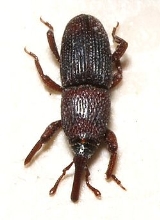
Wheat weevil
Encyclopedia
Wheat weevils also known as grain weevils or granary weevils, occur all over the world and are a common pest in many places. They can cause significant damage to harvested grains that are being stored and may drastically decrease yields. The females lay many eggs and the larvae eat the inside of the grain kernels.
All stages of the wheat weevils can be killed by either super heating or cooling. Heat in the microwave for 5 minutes or freeze at 0 °F for 4 days to get rid of them.
Identification
Adult wheat weevils are about 3-5mm length with elongate snouts and chewing mouthparts. Depending on the grain kernels, the sizes vary. In small grains, such as millet or milo maize, they are small in size, but they are larger in corn. The adults are a reddish-brown colour and lack distinguishing marks. Adult wheat weevils are not capable of flight. Larvae are legless, humpbacked and white with a tan head. Weevils in pupa stage have snouts like the adults.Life cycle
Female wheat weevils lay between 36 and 254 eggs and usually one egg is deposited in each grain kernel. All larval stages and the pupal stage occur within the grain. The larvae feed inside the grain until pupation, after which they bore a hole out of the grain and emerge. They are rarely seen outside of the grain kernel. The life cycle takes about 5 weeks in the summer, but may take up to 20 weeks in cooler temperatures. Adults can live for up to 8 months after emerging.Behaviour
Adult wheat weevils when threatened or disturbed will pull their legs close to the body and feign death. Female weevils can tell if a grain kernel has had an egg laid in it by another weevil. They will avoid laying another egg in this grain. Females chew a hole, deposit an egg, and seal the hole with a gelatinous secretion. This may be how other females know the grain has an egg in it already. This ensures the young will survive and produce another generation. Researchers estimate that one pair of weevils may produce up to 6,000 offsprings per year.Human Impact
Wheat weevils are a pest of many types of grain and may lay their eggs in wheat, oats, rye, barley, rice and corn. Wheat weevils cause an unknown amount of damage worldwide because it is hard to keep track of so much information, especially in places where the grain harvests are not measured. They are hard to detect and usually all of the grain in an infested storage facility must be destroyed. There are many ways to attempt to get rid of the wheat weevil. There are pesticides, different methods of masking the odour of the grain with unpleasant scents, and introducing other organisms that are predators of the weevils.Prevention and Control
Sanitation and inspection are the keys to prevent the infestation. Store grains in containers with tight lids in a refrigerator or a freezer and purchase in small quantities. If any suspicion has arisen, carefully examine the grains for adult insects or holes in the grain kernels. Another method is to immerse them in water. If they float to the surface, it is a good indication of infestation. Even if identified early, disposal may be the only effective solution.All stages of the wheat weevils can be killed by either super heating or cooling. Heat in the microwave for 5 minutes or freeze at 0 °F for 4 days to get rid of them.
See also
- Rice weevilRice weevilThe rice weevil is a serious stored product pest which attacks several economically important crops, including wheat, rice, and maize.- Description :...
(Sitophilus oryzae) - Maize weevilMaize weevilThe maize weevil , known in the United States as the greater rice weevil, is a species of beetle in the family Curculionidae. It can be found in numerous tropical areas around the world, and in the United States, and is a major pest of maize...
(Sitophilus zeamais) - Lixus concavusLixus concavusLixus concavus , is a member of the weevils group, also called the snout beetles. Rhubarb is a host, together with dock, sunflower and thistle.-Characteristics:...
The Rhubarb curculio weevil

